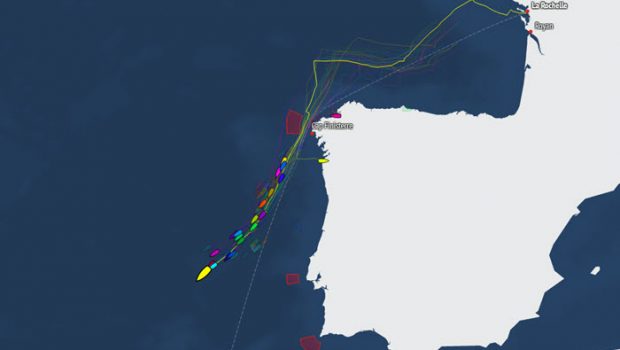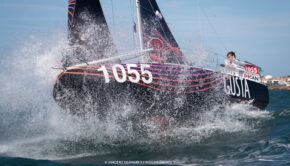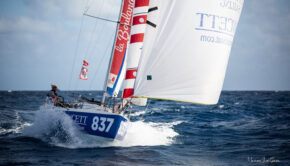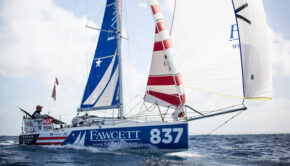Mini Transat: Wind is up, Surf is up
Published on October 9th, 2019
(October 9, 2019; Leg 1, Day 5) – Out on the racetrack this evening, the Mini-Transat La Boulangère fleet stretches from the latitude of Lisbon to Cape Finisterre. It’s been a very fast and exhilarating day, especially for the sailors further South, as the leaders set a hellish pace led by François Jambou (prototype) and Félix De Navacelle (production boat).
Though nobody has retired so far, four Mini sailors have been forced to make pit stops. Jean-Baptiste Ternon is back out on the racetrack now and Joe Lacey should follow suit shortly. As for David Kremer, his transom has opened up and he’s stopped off in Baiona.
All alone in the Spanish port, he will have to overcome the disappointment and try to quickly work out what his options are. Equally, Pavel Roubal (No.908 Pogo Dancer-Prokonzulta) from the Czech Republic also now appears to be heading towards the Spanish coast for a potential pit stop.
The sailors in the Mini-Transat La Boulangère 2019 are experiencing their fastest day yet in this first leg, which set out from La Rochelle on Octover 5 bound for Las Palmas de Gran Canaria. They should be able to rack up quite a pace tonight in a strong N’ly wind gusting up to 35 knots, and a good swell. As such they’re ticking off the miles before the breeze begins to ease tomorrow, set to become very timid off the Canaries in two day.
However, first things first. For now, the time is ripe for long surfs under spinnaker and high speed. The atmosphere is wet with lots of time spent at the helm. Any moments of respite must be kept to the bare minimum but when everything’s working well aboard, it’s sure to be one hell of a ride out there!
Prototypes: Jambou, Tréhin and Bouroullec in fine fettle
François Jambou, Axel Tréhin, and Tanguy Bouroullec are still leading the way in the prototype fleet. Barring technical issues, they probably won’t leave one other’s sides until the Canaries. Fully powered up, virtually on a run, they’ve been on a SW’ly course today. On top of the need to get the boat making good headway, they must be wondering about the best time to gybe. In 4th place, the only woman signed up for the prototype category this year, Marie Gendron, is sailing an excellent race ahead of a very scattered fleet. Vincent Lancien, 10th, has been relegated to 80 miles astern of the leader, whilst Nicolas Tobo, 20th, is over 200 miles off the pace.
Production boats: Leader switch
The game is more open among the production boats in that there are still a great many contenders for the top spots in Las Palmas de Gran Canaria. At the 16:00 UTC position report, Félix de Navacelle was in first place ahead of Guillaume L’Hostis, the latter having nailed the offshore option around the TSS at Cape Finisterre yesterday. In the Top 10 we find nine Pogo 3s whose skippers include Julien Letissier, Ambrogio Beccaria, Matthieu Vincent, Sébastien Guého, Benjamin Ferré, Lauris Noslier and Amélie Grassi. One sailor with a production scow bow is holding his own in this mix though, Florian Quenot lying in a very fine 3rd place. Another scow bow is up in 11th place skippered by Paul Cloarec.
Damage for Kremer; Ternon and Lacey to set sail again
A cruel blow for David Kremer. The transom on his prototype Bon Pied Bon Oeil (260) has opened up. David has made the port of Baiona near Vigo where he’s trying to boost his spirits and come up with various solutions that will enable him to get back into the race. Hopefully the name of his boat will have some influence as it translates as ‘fit as a fiddle’. At 16:00 UTC, Jean-Baptiste Ternon had bid farewell to La Coruña and Briton Joe Lacey was just about to leave Gijón, a fact his two young daughters will doubtless be thrilled about. Jonathan Chodkiewiez is still in La Coruña.
Kevin Bloch leading the ‘vintage’ fleet of production boats
Out on the racetrack, the match racing continues at every stage of the fleet, with everyone finding a fellow racer to pit themselves against. Some of the sailors on the older generation boats are posting some excellent performances, including Kevin Bloch on his 2007 Pogo 2 (No.697), who’s managing to keep up with some of the much more modern Minis. Jean Bachèlerie is putting in another outstanding effort on the oldest boat in the fleet of production boats (No. 428, launched in 2003), as is Japanese sailor Masa Suzuki (470), Russian Irina Gracheva (579), Frenchman Thomas Gaschignard (539) and Swiss sailor Mathieu Gobet (455) – to name but a few. These skippers are sailing a fantastic race according to their means. From front to back, the 87 women and men currently braving the Atlantic on the smallest offshore racing boats in the world all deserve recognition.
Ranking at 16:00 UTC
PROTOTYPE
1- François Jambou (865 – Team BFR Marée Haute Jaune) 653.7 miles from the finish
2- Tanguy Bouroullec (969 – Cerfrance) 15.6 miles behind the leader
3- Axel Tréhin (945 – Project Rescue Ocean) 17.4 miles behind the leader
PRODUCTION
1- Félix De Navacelle (916 – Youkounkoun) 696 miles from the finish
2- Guillaume l’Hostis (868 – Alternative Sailing-Constructions du Belon) 3.7 miles behind the leader
3- Florian Quenot (946 – Mini Skippy) 4.6 miles behind the leader
Event details – Entry list – Tracker – Facebook
The 87 Mini 6.50 solo sailors competing in the biennial Mini-Transat La Boulangère got underway from La Rochelle on the first leg to Las Palmas de Gran Canaria on October 5. The Mini 6.50 Class has competition in two divisions: the prototypes and the production boats.
Production boats are built out of fiberglass, have alloy masts, 1.6 meter draft, and prohibit material such as titanium, carbon fiber, and epoxy resin. Ten boats must have been built to qualify as an official production boat.
Prototypes, on their side, are free of these restrictions and have been, for years, the very first laboratory for sailing innovations. Canting keels, daggerboards, swinging wing masts, long poles for huge spinnakers, have been tried first on minis. New hull shapes with very wide waterlines and foils are the now the latest innovations.
Race Format:
The first leg started October 5 (delayed from September 22 due to storms) from La Rochelle, France and extends 1350 nm to Las Palmas de Gran Canaria. After an often complicated exit of the Bay of Biscay, sailors will expect some long slips down the Portuguese coast before arriving after 7 to 10 days in the Canary archipelago.
The second leg will start November 1 from Las Palmas de Gran Canaria and will take from 15 to 20 sailing days to complete the 2700 nm course and reach Le Marin in Martinique, French West Indies. Due to the numerous islands, the restart from the Canary can be tricky before reaching the famous trade winds that offer a long downwind run.
Source: Effetsmer










 We’ll keep your information safe.
We’ll keep your information safe.